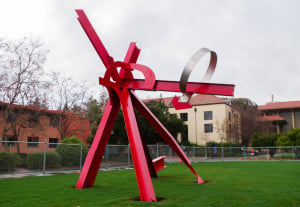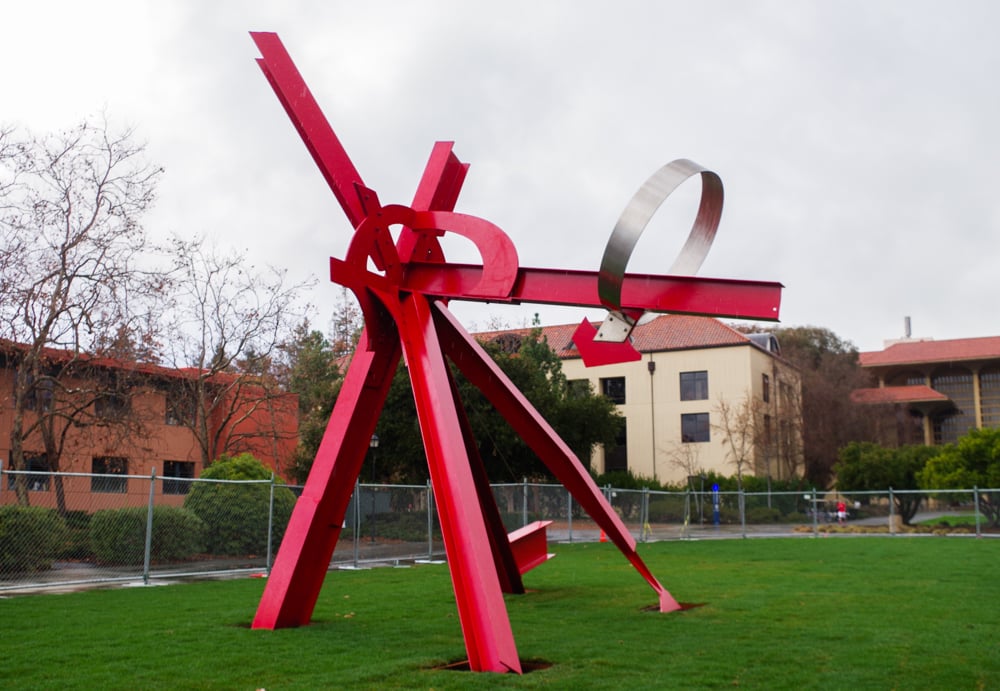
A 23-foot tall sculpture by Mark di Suvero has been moved across campus in recent weeks and is now almost completely installed in its new home.
The sculpture, titled “The Sieve of Eratosthenes,” was previously located near Cantor Arts Center, but the construction of the Anderson Collection building forced Cantor staff to relocate the sculpture to the grassy area between the Escondido turnaround and Meyer Library.
According to Susan K. Roberts-Manganelli, manager for collections, exhibits and conservation at Cantor, the new location was chosen because the open space will allow passersby to appreciate the scale of the work.
“This is a big piece and so you need a lot of space,” Roberts-Manganelli explained. “We never really liked the installation over by the museum. It was kind of hidden and the artist wasn’t pleased, so I think he’ll like this one a lot.
Because of its size, the sculpture had to be taken apart and reassembled in order to move it. Roberts-Manganelli said that the University worked closely with a fine arts handler and di Suvero himself to protect the work during transport.
“We always talk to the artist if the artist is still alive, and so we spoke with the artist and [the handlers] spoke with di Suvero,” Roberts-Manganelli said. “They talked about how best to take it apart because you can’t obviously take this and lift it up on a crane and put it on the back of a flatbed.”
Cantor staff also discussed the features of the new installment with di Suvero, particularly the square wooded-off areas where the feet of the sculpture are placed.
“The footings for [the sculpture] over by the museum were considered inappropriate for this location, so we had to design some new footings so it would be secure,” Roberts-Manganelli said. “Again, we had to talk to the artist about that and make sure that he agreed that the footings were right.”
“Sieve” is one of two di Suvero pieces on campus — the other is “Miwok,” a stainless steel work located on the Dean’s Lawn at the School of Medicine. Roberts-Manganelli said that the experience of moving that sculpture in August 2012 eased the planning process this time around.
Despite the best efforts of the handlers, the piece still needs retouching after the move, which Roberts-Manganelli said was normal procedure.
“Where the welding occurred, they removed some of the paint from the piece with the welder and then added new pieces of metal as well,” said Amanda Lynn, who painted the piece when it was first installed and will perform the touch-up work. “I’m going to be protecting the metal by using primer and paint for cosmetic sakes and also to prevent rust.”
Roberts-Manganelli emphasized that everything is done in accordance with the artist’s wishes.
“We always talk to the artist and keep extensive notes on what he says and what he wants,” Roberts-Manganelli said. She added the museum keeps detailed records of interviews and conversations so that even if an artist is no longer alive, the integrity of the piece is maintained.
According to Roberts-Manganelli, the piece will be fully installed and the fence surrounding it taken down in about a month, after the retouching work has been completed and the sod set. At that time, Cantor will hold an event to introduce the piece to the community.
“We’ll be having an event around it so that people know what it’s all about,” she said. “It’s here in the middle of a well-used lawn so we want people to understand what’s going on.”
Contact Jana Persky at jpersky ‘at’ stanfor ‘dot’ edu.
